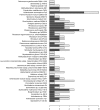Bioinformatic analysis reveals high diversity of bacterial genes for laccase-like enzymes
- PMID: 22022440
- PMCID: PMC3192119
- DOI: 10.1371/journal.pone.0025724
Bioinformatic analysis reveals high diversity of bacterial genes for laccase-like enzymes
Abstract
Fungal laccases have been used in various fields ranging from processes in wood and paper industries to environmental applications. Although a few bacterial laccases have been characterized in recent years, prokaryotes have largely been neglected as a source of novel enzymes, in part due to the lack of knowledge about the diversity and distribution of laccases within Bacteria. In this work genes for laccase-like enzymes were searched for in over 2,200 complete and draft bacterial genomes and four metagenomic datasets, using the custom profile Hidden Markov Models for two- and three-domain laccases. More than 1,200 putative genes for laccase-like enzymes were retrieved from chromosomes and plasmids of diverse bacteria. In 76% of the genes, signal peptides were predicted, indicating that these bacterial laccases may be exported from the cytoplasm, which contrasts with the current belief. Moreover, several examples of putatively horizontally transferred bacterial laccase genes were described. Many metagenomic sequences encoding fragments of laccase-like enzymes could not be phylogenetically assigned, indicating considerable novelty. Laccase-like genes were also found in anaerobic bacteria, autotrophs and alkaliphiles, thus opening new hypotheses regarding their ecological functions. Bacteria identified as carrying laccase genes represent potential sources for future biotechnological applications.
Conflict of interest statement
Figures




References
-
- Rodríguez-Rodríguez CE, Jelic A, Llorca M, Farré M, Caminal G, et al. Solid-phase treatment with the fungus Trametes versicolor substantially reduces pharmaceutical concentrations and toxicity from sewage sludge. Bioresource Technol. 2011;102:5602–5608. - PubMed
-
- Auriol M, Filali-Meknassi Y, Tyagi RD, Adams CD. Laccase-catalyzed conversion of natural and synthetic hormones from a municipal wastewater. Water Res. 2007;41:3281–3288. - PubMed
-
- Theuerl S, Buscot F. Laccases: toward disentangling their diversity and functions in relation to soil organic matter cycling. Biol and Fert Soils. 2010;46:215–225.
-
- Bugg TDH, Ahmad M, Hardiman EM, Singh R. Curr Opin Biotech 22: 394-400; 2011. The emerging role for bacteria in lignin degradation and bio-product formation. - PubMed
-
- Couto SR, Herrera JLT. Industrial and biotechnological applications of laccases: A review. Biotechnol Adv. 2006;24:500–513. - PubMed
Publication types
MeSH terms
Substances
LinkOut - more resources
Full Text Sources
Other Literature Sources
Molecular Biology Databases

